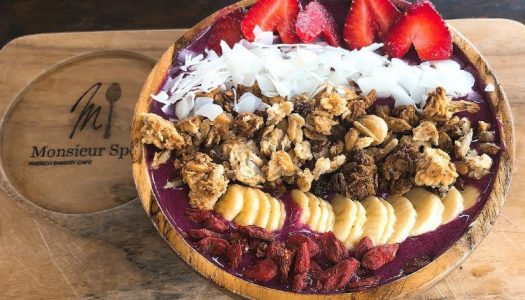But in spite of its mind-boggling variety of food options, sometimes the best food to be had is the local kindYes, Balinese cuisine has plenty to keep you interested for every meal throughout your stay. From the warungs (local street stalls) to the fine-dines, Indonesian food is affordable bycan be found in all budgets. Here’s our pick of the best that Balinese cuisine has to offer.
1. Nasi Goreng & Mee Goreng
By far the most popular Indonesian food export, both nasi and mee goreng are staples on the menus of most Asian restaurants abroad. However, the flavour that you’ll find here is unparalleled. This is essentially the national dish of Indonesia, as ubiquitous as fried rice is to China.
Nasi goreng is an Indonesian-style fried rice, mixed with meats (beef, chicken, pork, even shrimp) or vegetables and topped with a fried egg. It’s usually served with pickles, peanut sauce, pickled vegetables and prawn crackers on the side. Indonesia is full of rice fields, so it’s not surprising for it to become the staple grain of the country.
Locals eat nasi goreng for any or every meal, be it lunch, dinner, or breakfast. From roadside stalls to expensive restaurants, you’ll find this dish on every menu – and why not, for it is as delicious as it looks (and smells).
If you’re not a fan of rice, you’ll love nasi goreng’s variation, mee goreng, which is nothing but fried noodles served with the same toppings and condiments. Have it sweet or spicy – it really depends on your taste. All we know is that it’ll taste utterly divine!
2. Pisang Goreng
And while we’re on the topic of gorengs (that’s fried food in Indonesian), why should dessert be left behind? A local version of banana fritters, these are coated in batter and deep-fried, only to be served alongside honey or palm sugar syrup, powdered sugar, cinnamon, condensed milk, flaked coconut or vanilla ice cream.
Bananas are found everywhere in Bali, in sizes varying from the mini to the extra-large (we’ve heard bizarre cases of them being used as weapons!), with names such as pisang raja and pisang tanduk. The batter is usually a combination of wheat or rice flour, tapioca, and bread crumbs.
Locals usually have pisang goreng as an afternoon or mid-morning snack, but you don’t have to follow that rule – it is delicious absolutely any time of the day!
3. Sate
Don’t confuse this with the Malaysian satay – sate is the Indonesian version of marinated, grilled, and skewered meat served with a spicy sauce. The meat is grilled over charcoal or an open fire, resulting in a slightly sweet, slightly spicy but totally delicious dish moulded around a lemongrass stalk or wooden stick.
The Balinese use all kinds of meats to make this, including chicken, goat, mutton, beef, pork, fish, or even turtle. For a vegetarian version, tofu or eggs can also be used.
Known specifically as sate lilit, the meat (or vegetable) is minced, soaked with grated coconut, coconut milk, and a rich blend of vegetables and spices, after which it is wrapped around the sticks and grilled. Sate is usually served alongside a sauce – our favourite is the fiery sambal matah.
4. Babi Guling
If you’ve ever been to Bali, or know someone who’s come from Bali, or done research on Bali, you’ll know that the Balinese love their pork. Undoubtedly Bali’s most iconic dish, babi guling, or suckling pig, is a nose to tail delicacy featuring tender pork and local spices.
The pig is rubbed with turmeric, stuffed with a spice paste (usually a mix of coriander seeds, lemongrass, lime leaves, salam leaves, chillies, black pepper, garlic, red shallots, ginger and lesser galangal), and then cooked whole on a spit fire over coconut husks or wood till it reaches optimum tenderness.
This is then served on rice, with stewed vegetables, sayur urap (a vegetable salad in coconut chilli dressing), pork sausage, fried pork meat, and crispy skin. Originally a celebratory communal meal, you can now get babi guling everywhere, from warungs to five-star hotel restaurants.
This is not a dish for the weak, though, as the nose to tail concept means that you never know what part of the pig you’re eating.
5. Bebek Betutu
If you’re not a fan of pork, this dish makes for a suitably delicious alternative. Bebek betutu is basically a smoked duck, rubbed and stuffed with local spices, wrapped in an areca palm leaf or betel nut bark and smoked with the embers of rice husks for up to 24 hours. If you want to eat authentically cooked bebek betutu, you’ll have to give the restaurant a day’s notice to prepare it.
The dish is rich and juicy, with the meat easily falling off the bones and the delicious aroma of spices such as lemongrass, turmeric, and ginger. It is usually served with rice (what else?), sambal, and vegetable side dishes.
6. Gado Gado
Amid all the meat dishes on offer in Bali, it’s the vegetarian gado gado that stands out. One of the five national dishes of Indonesia, this is a salad dish made of slightly boiled, blanched or steamed vegetables and hard-boiled eggs, boiled potato, fried tofu and tempeh, and lontong (rice wrapped in a banana leaf), and is usually served with a peanut sauce.
Gado gado literally means “mix mix” in Indonesian and is best had cold (although many experts equally prefer to have it warm).
The key to a tasty gado gado is its sauce, which is essentially made of fried crushed savoury peanuts, sweet palm sugar, garlic, chilies, salt, tamarind and a squeeze of lime. Try having it at one of the roadside stalls – the flavour is absolutely delightful.
7. Balinese Kopi
While not really different from your conventional cup of Joe, kopi is grown in the north-eastern part of Bali, due to its fertile volcanic soil and ideal climate. You won’t find the traditional Java coffee in Bali – the beverage was introduced here from Lombok traders, which is why you’ll find cafes across the island serving up some delicious brews.
Bali is also where you can taste kopi luwak – the world’s most expensive coffee. Kopi luwak is brewed on beans that has been through the digestion system of a civet – a cat-like nocturnal mammal.
The civets eat the coffee cherries for their fleshy pulp, but the beans are left intact all the way through the digestion system.
With a usual retail price as high as US$ 700 per kilo per pound, you can pick up low-grade variants at large grocery stores for as little as US$ 100 a kilo. How’s that for cost-cutting?
8. Jimbaran Seafood
This is not strictly a dish, but the freshly grilled seafood options available along Jimbaran beach deserve a mention by themselves. The entire stretch has eateries serving up a wide variety of seafood, including shrimp, clams, crabs, calamari, lobsters and a wide assortment of fish, at affordable rates.
You can pick your seafood either a la carte or by weight, and it will come to you along with accompaniments. Alternatively, you can choose a set meal, too.
We love how the fresh seafood arrives cooked just right in a bright red sauce that’s sweet and spicy. The best places to have it are Jimbaran Seafood Cafes and Jimbaran Bay Seafood Club.
9. Sambal Matah
While sambal is popular across Indonesia (there are more than 300 varieties available across the country), Bali’s own unique take is called sambal matah. Here, the mix involves the use of shallots, lemongrass, garlic, chilli and lime.
These ingredients are then kneaded along with hot oil, salt, sugar and a dash of shrimp paste. Use this as an accompaniment to your favourite meat dish, or, if you dare, eat it by itself.
10. Lawar
First things first – this dish is not for the faint of heart. A Balinese meat salad, made from minced pork, dragonflies, turtles, or offal, the meat is mixed along with young jackfruit, coconut, galangal, chilies, spices, and fresh blood. Yes, we actually mean fresh blood.
The blood is usually added to strengthen the flavour of the dish, and gives lawar its distinctive red colour. Because the blood to be used has to be fresh, this is not a dish you can store for long. And if the thought of all this is making you squeamish, fear not – there’s also a “white” version without any blood for the conventionally minded.
11. Laklak
A traditional Balinese teacake, laklak’s main ingredients are rice flour and coconut milk. Its shape is round and flat, almost like a pancake, and it comes in two colours – white and green.
The latter is the more distinctive one, and gets its colour from crushed pandan leaves that are added to the dough. You’ll get this mouth-watering sweet dish at all local markets, and each of them is equally delicious.
Sprinkled with grated coconut or a brown sugar sauce with jackfruit, it is best enjoyed with a cup of tea or coffee.
12. Bakso
These are literally Indonesian meatballs, served in hot soup, along with noodles and fried dumplings. The meat usually used in bakso is beef, although sometimes chicken or pork can also be used.
Bakso is largely a street food and, much as you see momo vendors around the city, you’ll see carts full of bakso being pushed around in the markets and on the road. This is the perfect snack to eat on a cold winter day, as it’s served hot and steaming.






